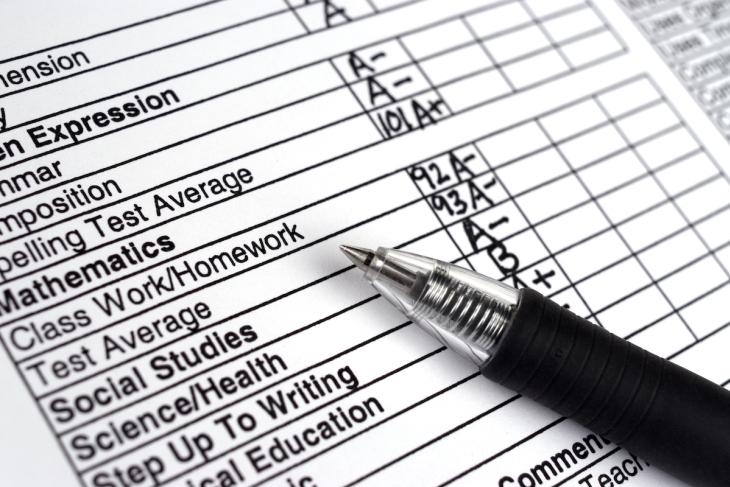School closures and remote learning led to widespread relaxation of student accountability at the onset of the coronavirus pandemic. Lax requirements to turn in work, fewer graded assignments, and—most perniciously—policies mandating “no zeros” or “no failing grades” were adopted (or accelerated) to lighten the load of young people whose worlds had been turned upside down. Now that school schedules have returned to normal, a descriptive study from CALDER examines whether grading policies have begun to do the same, too.
Authors Dan Goldhaber and Maia Goodman Young examine evidence of grade inflation before and after Covid-19 in Washington State. In March 2020, Washington’s Office of Superintendent of Public Instruction (OSPI) advised schools to consider the adoption of “pass/no credit” grading policies. A month later, as it became clear that closures would be a long-term proposition, OSPI revised its guidance to specify that high school students (and middle schoolers taking high-school-credit-bearing classes) could not be given pass/no credit marks, but could be awarded grades of “incomplete,” with the hope that they would complete their coursework in the future. The bottom line, however, was that no student could receive a lower final grade than whatever they had already earned when schools shut down in March.
Come fall of the 2020–21 school year, when some Evergreen State districts switched to in-person or hybrid learning modes, teachers were allowed to assign failing grades again, but the flexibility of the directive led districts to implement a range of policies. Leaders in Seattle, for instance, instructed teachers to keep grades within an A-to-C-minus range (or incomplete).
The study examines the relationship between test scores and grades and how grades and average GPAs have shifted over time. The analysis uses student-level data—specifically, test scores and grades earned in high-school-credit-bearing courses in English, math, and science for students from the 2010–11 through 2021–22 school years, including middle schoolers who took courses for high school credit—primarily Algebra 1 and geometry. While the covered timeframe is just barely “post”-pandemic, it will be important later to compare these early trends to future ones.
Prior to the pandemic, the results show a slight uptick in math and English grades. But consistent with state guidance, almost no students received an F grade in the spring of 2020. Failing grades dropped from 9.5 percent to 1.3 percent in English courses, 9 percent to 1 percent in math courses, and 8.6 percent to 1.1 percent in science between the fall and spring semesters of 2020. The distribution of grades higher than F mostly increased in that time, with the share of A’s specifically jumping from 33 percent to 56 percent in math; from 36 percent to 60 percent in English; and from 33 percent to 59 percent in science. From fall to spring 2020, the average GPA in math jumped from 2.6 to 3.2, in English from 2.7 to 3.3, and in science from 2.6 to 3.3.
Fast forward a single year, however, and signs of stability emerged. By 2021–22, English and science grades had largely returned to pre-pandemic levels, though math grades remained high. (The average math GPA in 2021–22 was 2.7, 0.4 points higher than it was in 2018–19.)
As for shifts in the relationship between grades and test scores, Goldhaber and Young predict students’ placement in the test distribution based on letter grades received in respective years. They find that their position drops for all math subjects between the first year of observed test scores (2015–16) and the first year of testing after the pandemic (2021–22). In other words, a student who got an A in Algebra 1 was predicted to be in the 73rd percentile of the test distribution in 2015–16, the 68th percentile in 2018–19, and the 58th percentile in 2021–22. In Algebra 2, a student receiving an A was predicted to be in the 64th percentile in 2015–16, the 58th percentile in 2018–19, and the 54th percentile in 2021–22. But these predictions do not hold true in all subjects. In geometry, for instance, the shifts in grading standards mostly stabilized, and in English they were not as big as in math.
The report’s conclusion draws attention to the misalignment between grades and achievement in Algebra 1, given that course is a gateway class to higher math courses in high school. If students aren’t properly identified for help at this juncture, they may not succeed in those more challenging classes.
It’s a huge problem when students who earn top grades fail to demonstrate mastery of key skills and knowledge on a state test. But the need to right-size grades is about more than wrong signals. There’s growing alarm that an extended hiatus from grade-based accountability is a surefire way to “lock in” pandemic learning loss for the long term. That’s a sobering thought, given more-recent evidence on learning loss.
As educators and policy leaders finally take seriously the harm that cellphones do to learning, it’s fair to ask what it will take for them to recognize the same about grade inflation?
SOURCE: Dan Goldhaber and Maia Goodman Young, “Course Grades as a Signal of Student Achievement: Evidence on Grade Inflation Before and After COVID-19,” Center for Analysis of Longitudinal Data in Education Research—CALDER (November 2023).




